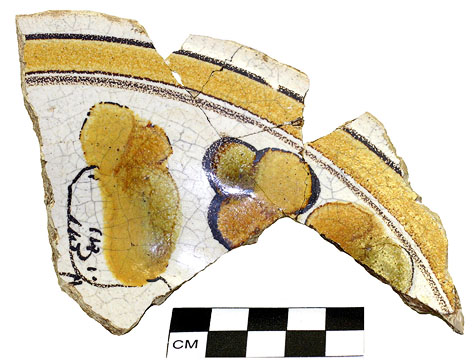|  |  |  |  | | Tin-Enameled Bowl Made in Puebla, Mexico |  | | This is a fragment of a tin-enameled brimmed bowl made in Puebla, New Spain. Tin-enameled wares were first developed in the Near East, and are distinguished by the opaque white background. This opaque white background is achieved by adding tin oxide to the surface coating that results in an opaque surface coating or enamel. This is not technically a glaze, which is a surface coating that is transparent or translucent. From the Near East, the tin-enameled tradition spread to North Africa with the Phoenicians, and then to Spain with the Muslims. The Spanish tin-enameled wares were shipped from the Spanish port of Majorca to Italy, and the Italians called the ware "maiolica." The Italian tin-enameled wares were shipped to France and Holland from the Italian port of Faenza, and the French and Dutch referred to the ware as "faience." The English imported much tin-enameled pottery from the Dutch city of Delft, and the English referred to tin-enameled ware as delft. In New Spain, tin-enameled wares are called talavera, after the Spanish city that was known for its tin-enameled pottery manufacture. Most of the tin-enameled wares recovered from Los Adaes come from Puebla, and reflect a combination of influences from Asia, Italy, and the Muslim world. This particular example of Puebla tin-enameled ware shows an Italian color scheme and a figure wearing a turban, sometimes referred to as a "portly, eunuch-like figure" with near eastern influenced clothing. |  | Photo credit: George Avery
Source: Williamson Museum, Northwestern State University, Natchitoches, Louisiana |  |
|  |
|
